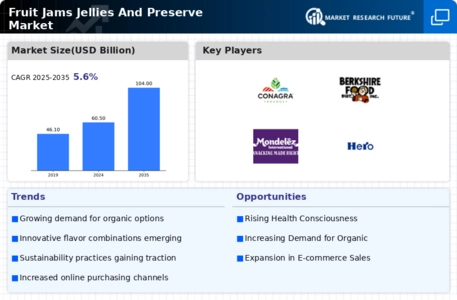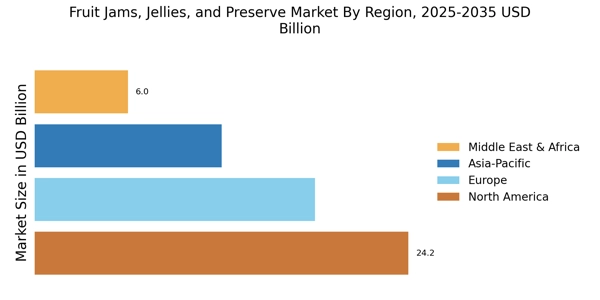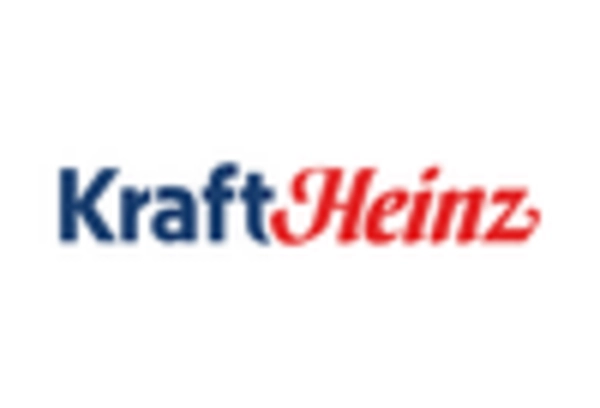E-Commerce Growth
The rapid expansion of e-commerce platforms is transforming the Fruit Jams, Jellies, and Preserve Market. As consumers increasingly turn to online shopping for convenience, the availability of fruit preserves through digital channels has surged. In 2023, online sales accounted for nearly 30% of total market revenue, reflecting a significant shift in purchasing behavior. This trend is particularly pronounced among younger consumers who prefer the ease of ordering products online. E-commerce not only provides access to a wider variety of brands and flavors but also facilitates direct-to-consumer sales, allowing manufacturers to engage with their customers more effectively. The continued growth of e-commerce is expected to play a crucial role in the industry's evolution.
Health-Conscious Choices
The increasing consumer inclination towards health-conscious choices is a pivotal driver for the Fruit Jams, Jellies, and Preserve Market. As individuals become more aware of the nutritional content of their food, there is a growing demand for products that are low in sugar and free from artificial preservatives. This trend is reflected in the market, where sales of organic and natural fruit preserves have surged, indicating a shift towards healthier alternatives. In 2023, the market for organic jams and jellies accounted for approximately 25% of total sales, showcasing the potential for growth in this segment. Consumers are actively seeking products that align with their health goals, which is likely to propel the industry forward as manufacturers adapt to these preferences.
Flavor Innovation and Variety
Flavor innovation and variety are critical drivers in the Fruit Jams Jellies And Preserve Market. Consumers are increasingly seeking diverse and exotic flavors that go beyond traditional offerings. This demand for variety has prompted manufacturers to experiment with unique combinations, such as spicy, savory, and tropical fruit blends. In recent years, the introduction of innovative flavors has contributed to a notable increase in market share for niche products, with some brands reporting growth rates of up to 20%. This trend suggests that consumers are eager to explore new taste experiences, which could lead to a broader acceptance of unconventional flavors in the industry. The focus on flavor innovation is likely to remain a key factor in attracting and retaining customers.
Gourmet and Artisanal Products
The rising popularity of gourmet and artisanal products is significantly influencing the Fruit Jams, Jellies, and Preserve Market. Consumers are increasingly drawn to unique flavors and high-quality ingredients, often sourced from local producers. This trend has led to a proliferation of small-scale manufacturers who emphasize craftsmanship and authenticity in their offerings. In recent years, the market for gourmet jams has expanded, with sales growth reported at around 15% annually. This shift towards premium products suggests that consumers are willing to pay a premium for quality, thereby creating opportunities for brands that can effectively market their artisanal credentials. The emphasis on gourmet options is likely to continue shaping consumer preferences in the industry.
Sustainability and Eco-Friendly Practices
The emphasis on sustainability and eco-friendly practices is becoming increasingly relevant in the Fruit Jams, Jellies, and Preserve Market. Consumers are more inclined to support brands that prioritize environmentally responsible sourcing and packaging. This trend is evident as companies adopt sustainable practices, such as using recyclable materials and sourcing fruits from organic farms. In 2023, approximately 40% of consumers reported that they consider sustainability when purchasing food products, indicating a strong market demand for eco-friendly options. As awareness of environmental issues continues to grow, brands that align with these values are likely to gain a competitive edge in the industry. The focus on sustainability may also drive innovation in product development and packaging solutions.


















Leave a Comment